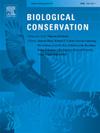超越经典入侵假说:调查农业景观简化对野猪种群的影响
IF 4.4
1区 环境科学与生态学
Q1 BIODIVERSITY CONSERVATION
引用次数: 0
摘要
世界范围内的集约化农业造成了景观的简化,不仅减少了原生植被覆盖,而且减少了景观的异质性。然而,景观简化如何影响生物入侵尚不确定。这是因为生物入侵的经典假设集中在单一的预测因素上,对其影响做出了相互矛盾的预测。在这里,我们从经典假设中探索预测因子的组合,以研究景观简化如何影响世界上最有害的入侵物种之一-野猪(Sus scrofa)。我们依赖于55个景观的分层抽样设计,最大限度地提高景观异质性和原生植被覆盖之间的不相关变化。通过比较Royle和Nichols的野猪丰度模型,我们考虑了三组预测因子的线性和非线性、简单的加性和交互效应:景观干扰(土地覆盖的变化)、景观异质性(土地覆盖多样性/配置的变化)和生物相互作用(捕食者的存在/缺失和本地物种丰富度的变化)。所有排名最高的模型都包含了景观异质性和开阔植被覆盖之间的交互效应。我们的发现不支持生物入侵的经典假设。我们没有发现生物控制、原生植被丧失或景观异质性对野猪丰度的线性影响。相反,研究结果表明,景观异质性的影响取决于开阔植被覆盖的数量。这些结果挑战了农业生态系统中基于自然的入侵控制指南,并表明调查包含景观的马赛克视图和预测因子的复杂关系的相关性,为特定环境的入侵控制指南提供支持。本文章由计算机程序翻译,如有差异,请以英文原文为准。
Beyond classical invasions hypotheses: Investigating the impact of agricultural landscape simplification on wild pig populations
Worldwide intensive agriculture has caused simplification of landscapes, reducing not only native vegetation cover but also landscape heterogeneity. Yet, how landscape simplification may affect biological invasion is uncertain. This is because classical hypotheses of biological invasion focus on single predictors, making contradictory predictions on its effects. Here, we explore combinations of predictors from classical hypotheses to investigate how landscape simplification affects one of the most harmful invasive species worldwide – the wild pigs (Sus scrofa). We rely on a hierarchical sampling design across 55 landscapes maximizing uncorrelated variation between landscape heterogeneity and native vegetation cover. By comparing Royle and Nichols models of wild pig abundance, we consider linear and non-linear, and simple, additive and interactive effects of three groups of predictors: landscape disturbance (changes in landcovers), landscape heterogeneity (changes in landcover diversity/configuration) and biotic interactions (predator presence/absence and changes in native species richness). All best-ranked models included an interactive effect between landscape heterogeneity and open vegetation cover. Our findings suggest no support to classical hypotheses of biological invasion. We find no support for either biotic control, native vegetation loss or a linear impact of landscape heterogeneity on wild pig abundance. Instead, results suggest a strong context dependence, with landscape heterogeneity effects depending on the quantity of open vegetation cover. These results challenge a general nature-based guideline to invasion control in agroecosystems and suggest the relevance that investigations embrace a mosaic view of landscapes and the complex relationship of predictors, giving support to context-specific guidelines to invasion control.
求助全文
通过发布文献求助,成功后即可免费获取论文全文。
去求助
来源期刊

Biological Conservation
环境科学-环境科学
CiteScore
10.20
自引率
3.40%
发文量
295
审稿时长
61 days
期刊介绍:
Biological Conservation is an international leading journal in the discipline of conservation biology. The journal publishes articles spanning a diverse range of fields that contribute to the biological, sociological, and economic dimensions of conservation and natural resource management. The primary aim of Biological Conservation is the publication of high-quality papers that advance the science and practice of conservation, or which demonstrate the application of conservation principles for natural resource management and policy. Therefore it will be of interest to a broad international readership.
 求助内容:
求助内容: 应助结果提醒方式:
应助结果提醒方式:


